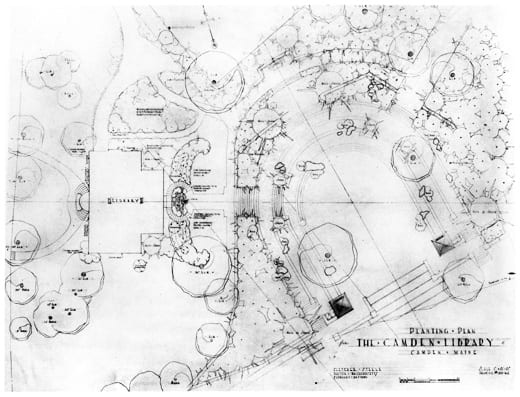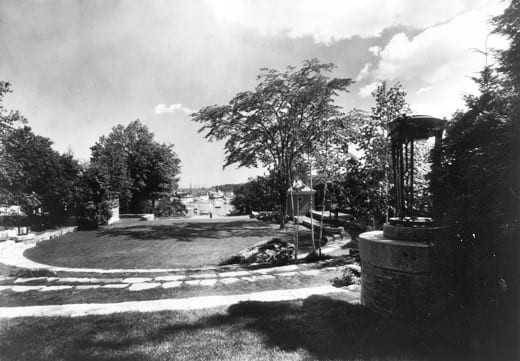Steele’s Amphitheater Becomes National Historic Landmark
Steele’s Amphitheater Becomes National Historic Landmark

On Monday, March 11th, the U.S. Secretary of the Interior announced that Camden Amphitheater, one of Fletcher Steele’s few public projects, is one of the thirteen National Historic Landmarks designated this year. The outdoor theater lies behind the Camden Public Library, overlooking the harbor on West Penobscot Bay. It was designed in 1928 by Fletcher Steele.
As the foremost expert on Steele’s life and work, Robin Karson brought the landscape architect’s professional accomplishments to public attention in 1989 with the publication of Fletcher Steele, Landscape Architect: An Account of the Gardenmaker’s Life, 1885-1971. In her ground-breaking book, Karson describes some of the “quietly revolutionary aspects” of the landscape architect’s design for the Camden Amphitheater. This project represents Steele’s early experimentation with the “bent axis,” in this case the amphitheater in line with the harbor view rather than its companion library, a particularly modern choice in this conservative setting. Rather than depending on an architectural style, Steele arranged native plants and large rocks in the terraces for “architectural and decorative impact.” This use of natural materials contrasted with his design of the outdoor theater’s tripod lights, which add a civilizing sense of the past. With the bustling harbor as a focal point, the theater space seems to extend across the street to the marine landscape, which includes a sloping park designed by Frederick Law Olmsted Jr. during the same time Steele was creating the amphitheater.

Ten years ago, the LALH website featured a preservation case study on both the harborside park and the amphitheater, which were then undergoing restoration by Patricia O’Donnell, FASLA, principal of Heritage Landscapes. This landmark designation not only confirms the value of Steele’s work at a national level, but also provides additional stimulus for the town and the state to maintain the integrity of its “national treasure.” A new edition of Fletcher Steele, Landscape Architect, was published by LALH in 2003, bringing Steele’s reputation to a worldwide audience. Since that time, Steele’s renown has continued to rise.

Lucinda Brockway, author of the National Historic Landmark nomination, says, “Fletcher Steele, Landscape Architect was instrumental in our scholarship for the successful National Historic Landmark nomination, and it will continue to serve as a seminal guide for management of the Camden Amphitheater, providing site-specific historical information and design context for this masterwork. Karson’s comprehensive study of Steele’s work not only raised awareness for the importance of the amphitheater as a historic landscape, but set the garden within its context, proving its national significance as one of the nation’s finest examples of early American Modernism in landscape architecture.”
For more on Steele, watch the LALH film: Fletcher Steele and Naumkeag: A Playground of the Imagination